Table of Contents
- Introduction
- Editor’s Choice
- Global Honey Market Overview
- Nutrition Facts About Honey
- Honey Constituents That Present Health-Promoting Effects and Nutritional Value
- Top Consumers of Honey in The World
- Honey Production Statistics
- Leading Exporting Nations
- Leading Importing Nations
- Regulatory Guidelines for Honey
Introduction
According to Honey Statistics, Honey, a sweet substance produced by bees from the nectar of flowers is renowned for its extensive history of application in cooking, traditional remedies, and therapeutic practices. Its composition consists of sugars like glucose and fructose, alongside water and other natural constituents.
Bees gather nectar from flowers using their proboscis and undergo a digestive process to convert it into honey.
Various sorts of honey are accessible, each possessing a unique flavor influenced by the specific flowers bees visit. People use it as a natural sweetener in culinary dishes, appreciate its potential health benefits, and integrate it into both cosmetic products and cooking, owing to its inherent attributes.
Editor’s Choice
- In 2023, the global honey market recorded a revenue of USD 9.3 billion.
- Organic honey dominates the market with a commanding 78% market share, indicating a strong preference among consumers for natural and sustainably produced products.
- The predominant component is carbohydrates, making up 17.3 grams of its content.
- The consumption of honey per capita varies significantly across different countries, with the Central African Republic leading the list by a considerable margin, with its citizens consuming an average of 9.62 grams daily.
- In 2021, the global production of natural honey was led by China, emerging as the undisputed leader with an impressive production volume of 472.7 thousand metric tons.
- Leading the import list was the United States (U.S.A) with an impressive import quantity of 220,232 metric tonnes and a corresponding value of USD 667 million.
- The Codex Alimentarius Commission has established 15 parameters concerning standards. For instance, the moisture content, except for heather honey, should not exceed 20%.
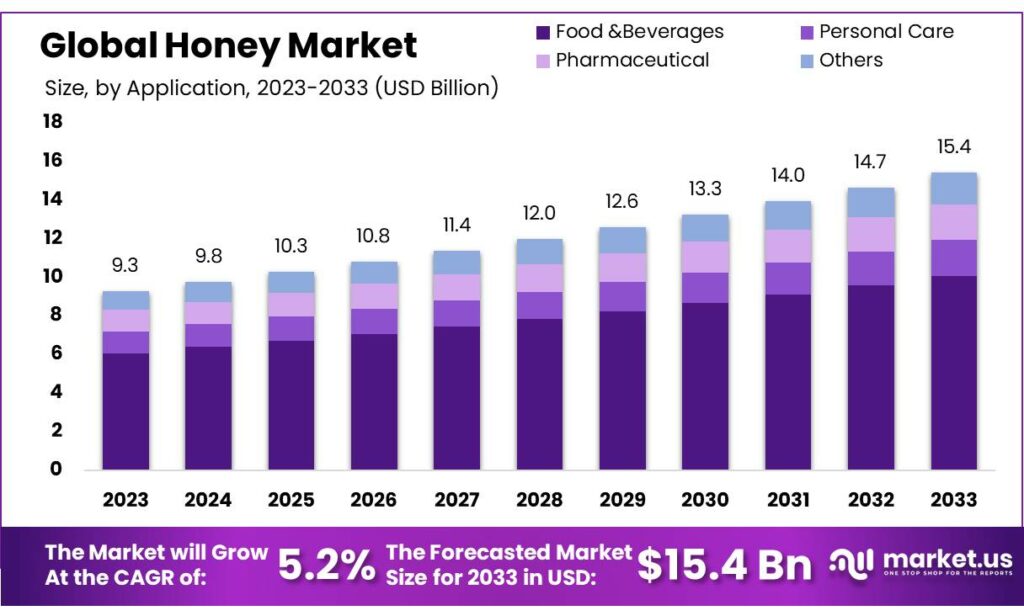
Global Honey Market Overview
Global Honey Market Size
- The global honey market is on a consistent upward trajectory at a CAGR of 5.2%, with revenue projections showcasing steady growth over the next decade.
- In 2023, the market recorded a revenue of USD 9.3 billion, which is expected to increase to USD 9.8 billion in 2024.
- Furthermore, the market is forecasted to reach USD 12.0 billion in 2028, USD 12.6 billion in 2029, and an impressive USD 13.3 billion in 2030.
- This growth trajectory persists, with anticipated revenues of USD 14.0 billion in 2031 and USD 14.7 billion in 2032, culminating in a projected revenue of USD 15.4 billion by 2033.
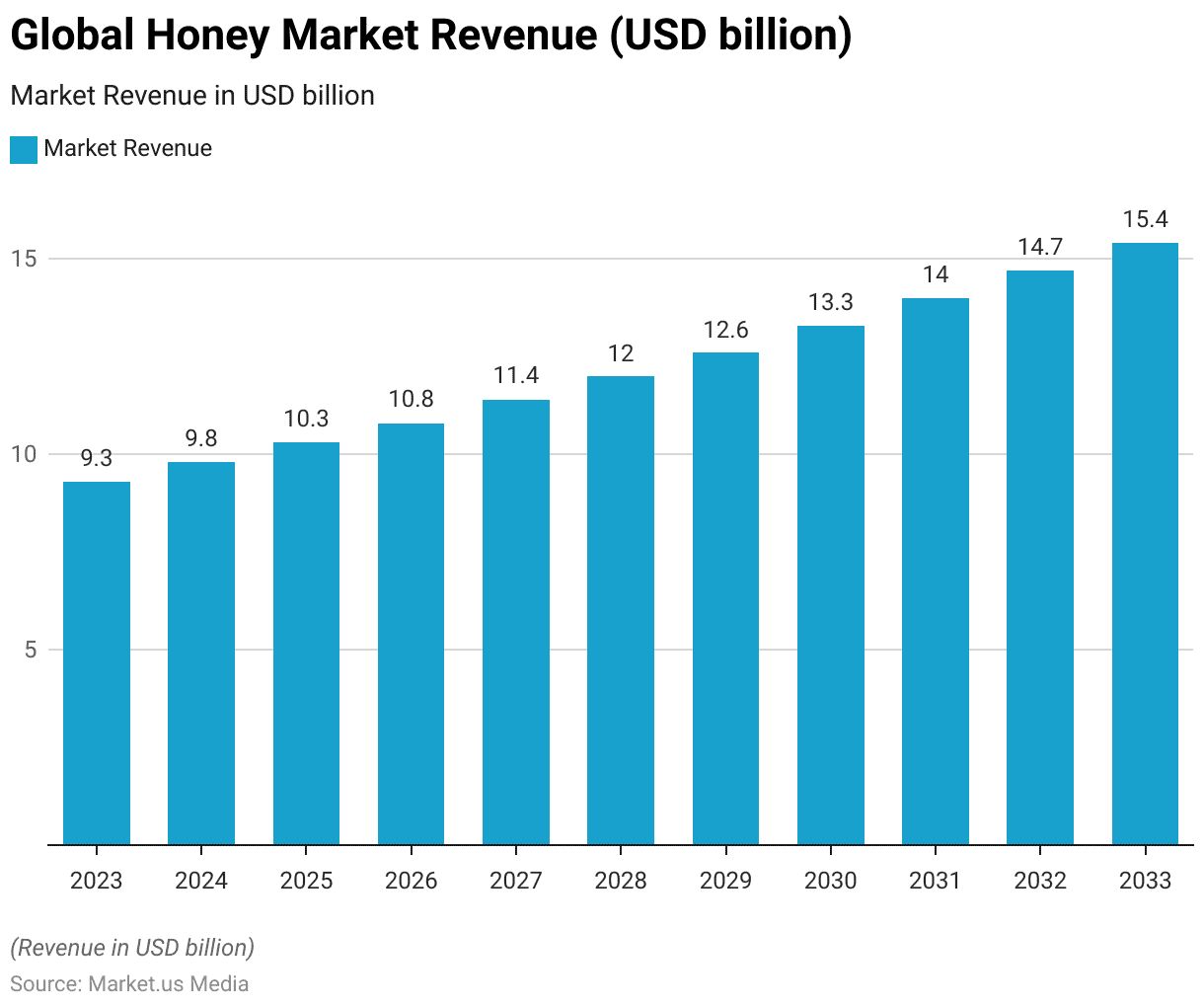
Honey Market Share – By Processing
- A significant market share disparity between different processing types characterizes the global market.
- Organic honey dominates the market with a commanding 78% market share, indicating a strong preference among consumers for natural and sustainably produced products.
- This robust market presence of organic reflects the growing awareness of health-conscious consumers who seek products free from synthetic chemicals and pesticides.
- In contrast, conventional honey holds a comparatively smaller market share, accounting for 22% of the overall market.
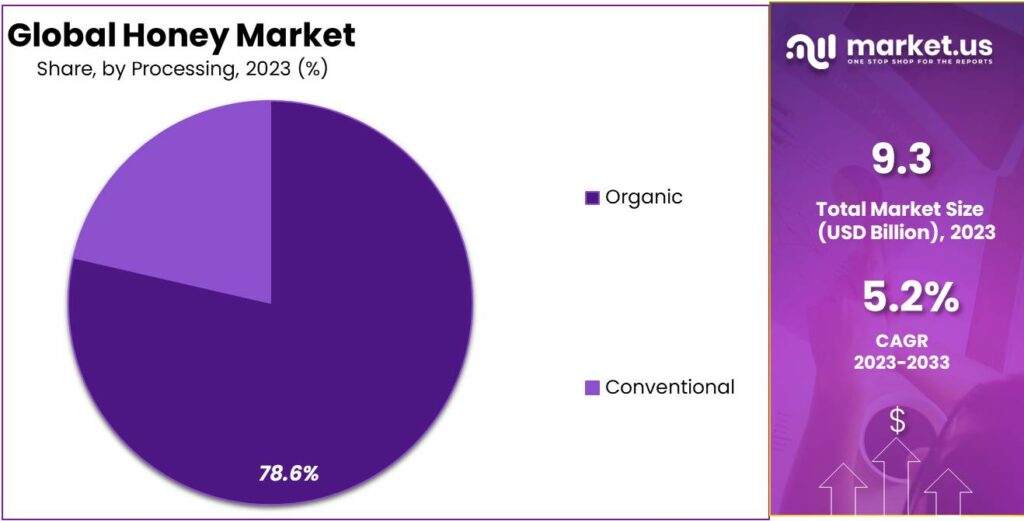
Nutrition Facts About Honey
- Honey, a natural and sweet substance, is not only known for its delightful flavor but also for its nutritional composition.
- In a single tablespoon (approximately 21 grams), it contains a minimal amount of protein, with just 0.06 grams. It is virtually fat-free, containing no total lipids (fat).
- The predominant component is carbohydrates, making up 17.3 grams of its content.
- With an energy value of 63.84 kilocalories per tablespoon, serves as a source of quick energy due to its high sugar content, with 17.25 grams of sugar in the same serving.
- While it doesn’t provide a significant amount of dietary fiber, with only 0.04 grams, honey does offer trace minerals such as calcium (1.26 mg), iron (0.09 mg), magnesium (0.42 mg), phosphorus (0.84 mg), potassium (10.92 mg), and trace amounts of zinc (0.05 mg), copper (0.01 mg), manganese (0.02 mg), and selenium (0.17 mcg).
- In terms of vitamins, it contains minimal amounts of vitamin C (0.1 mg), thiamin (0 mg), riboflavin (0.01 mg), niacin (0.03 mg), pantothenic acid (0.01 mg), vitamin B-6 (0.01 mg), and a small quantity of folate (0.42 mcg).
Honey Constituents That Present Health-Promoting Effects and Nutritional Value
- Over the past few years, from 2015 to 2021, extensive research has shed light on the diverse constituents of honey and its potential health-promoting effects, reaffirming its nutritional value.
- Sugars and related compounds constitute a significant portion, accounting for 30% of honey’s composition, which provides a sweet taste and serves as a source of energy.
- Amino acids and proteins make up 20%, offering essential building blocks for the body’s tissues and contributing to potential nutritional benefits.
- Lipids and related compounds, comprising 18%, provide some fats and lipid-based compounds, which, although in smaller quantities, contribute to the overall nutritional profile.
- Vitamins, constituting 16%, impart essential micronutrients to honey, enhancing its appeal as a wholesome food.
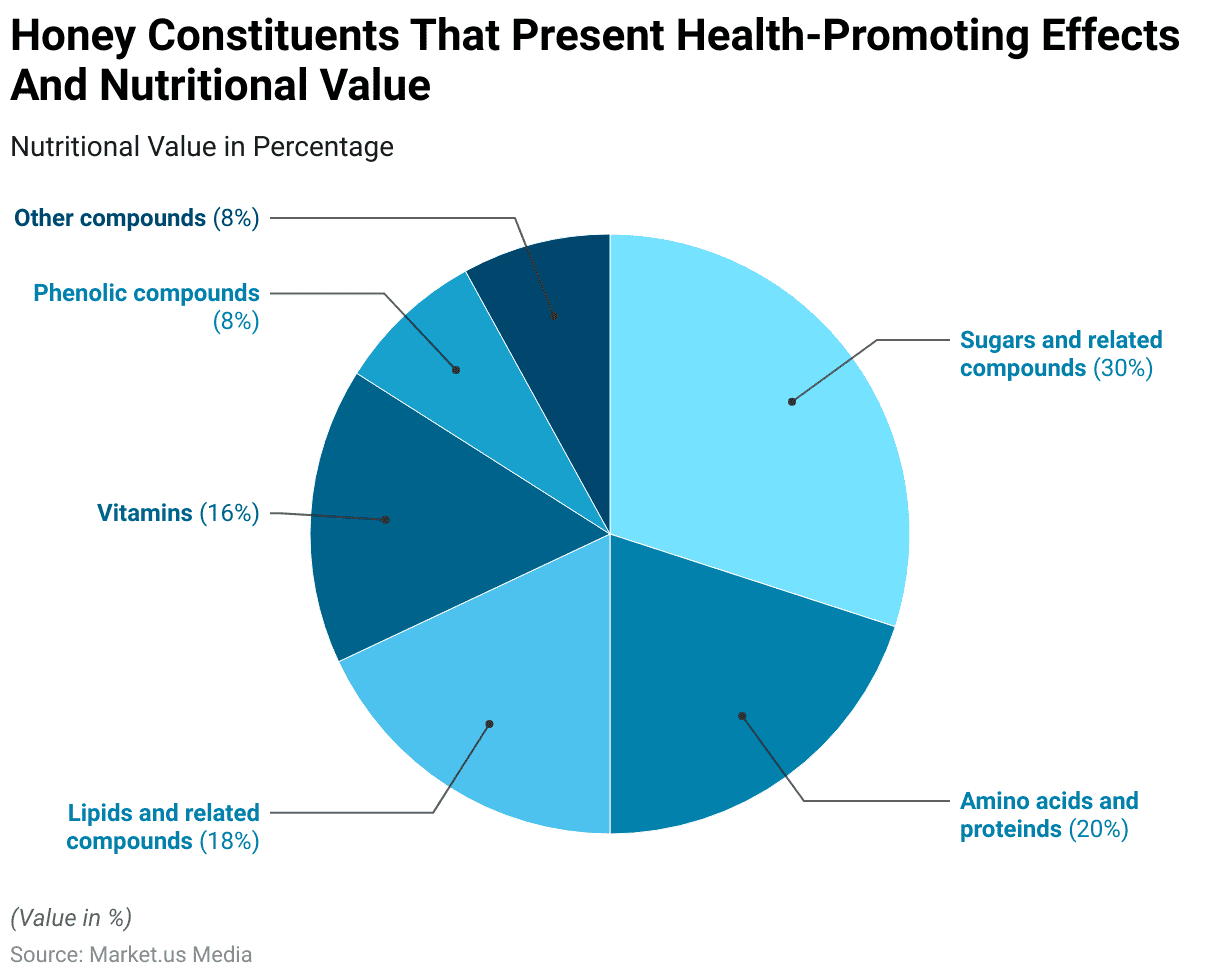
Top Consumers of Honey in The World
- The consumption of honey per capita varies significantly across different countries, with the Central African Republic leading the list by a considerable margin, with its citizens consuming an average of 9.62 grams daily.
- New Zealand follows closely in second place, where the daily per capita consumption stands at 5.55 grams, reflecting the popularity in the region.
- Slovenia ranks third with an average daily intake of 4.4 grams, showcasing a notable appreciation for honey among its population.
- Greece and Switzerland also display a fondness for honey, with daily per capita consumption figures of 4.24 grams and 3.87 grams, respectively.

Honey Production Statistics
- As per the Food and Agriculture Organization of the United Nations (FAO), global production per person saw a significant 42.9% rise from 1961 to 2017.
- At a worldwide scale, honey production per individual increased by 15.6%, going from 218 kilograms per 1000 people in 1961 to 252 kilograms per 1000 people in 2017.
- This increase was most notable in Asia and South America, while Oceania experienced a considerable decline, and Africa, Europe, and North America saw relatively smaller decreases.
Natural Honey-Producing Nations Leading
- In 2021, the global production of natural honey was led by China, emerging as the undisputed leader with an impressive production volume of 472.7 thousand metric tons.
- China’s significant contribution to the industry underscores its vast agricultural resources and expertise.
- Following China, Turkey secured the second position with a production of 96.34 thousand metric tons, a notable presence in the global market.
- Iran, Argentina, and Ukraine also made substantial contributions with production figures of 77.15 thousand metric tons, 71.32 thousand metric tons, and 68.56 thousand metric tons, respectively.
- India, Russia, Brazil, Canada, and the Republic of Korea also featured prominently among the leading global honey producers, each producing substantial quantities ranging from 55.38 thousand to 66.28 thousand metric tons.
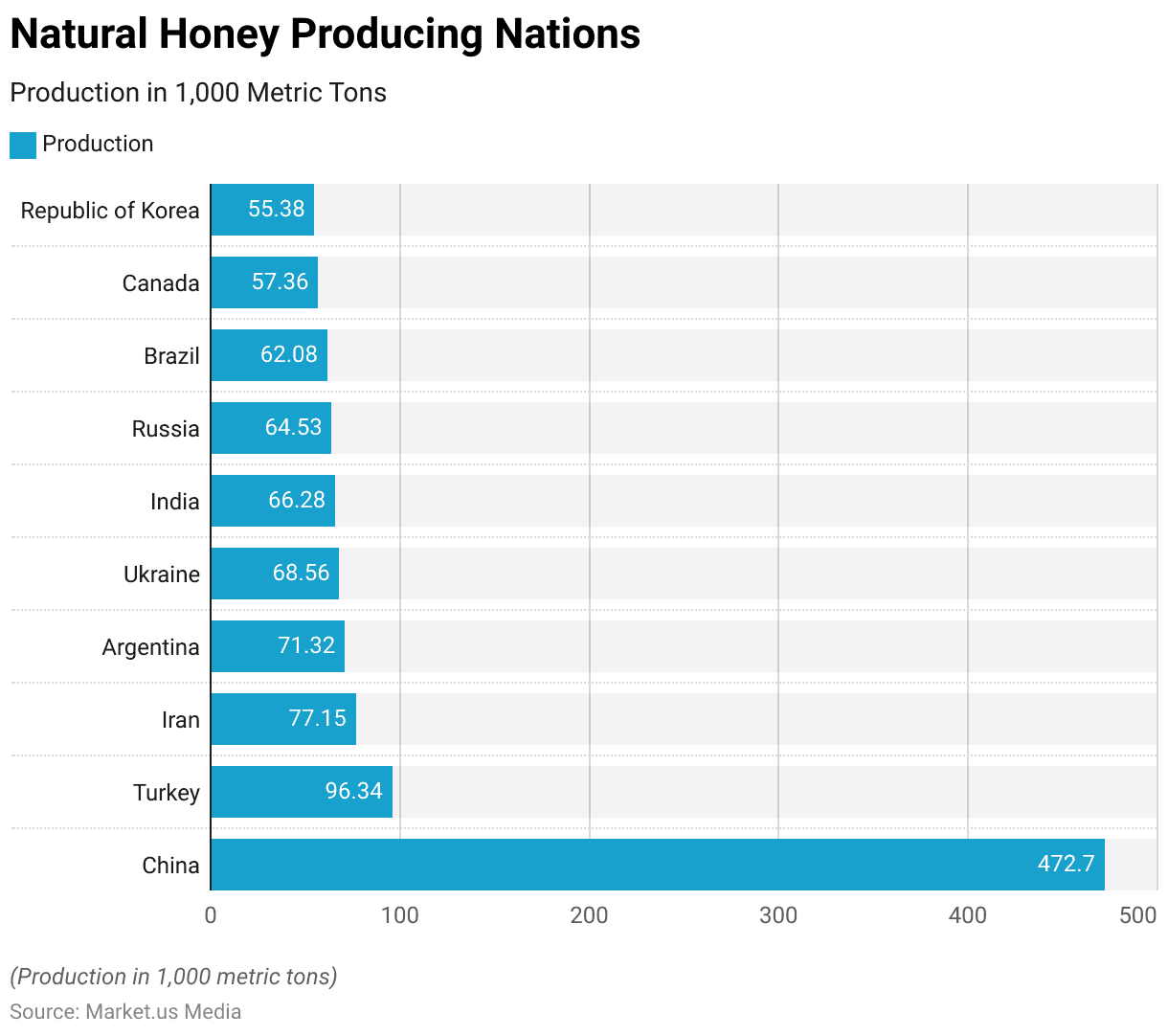
Leading Exporting Nations
- In terms of honey exports, several countries made significant contributions to the global market in 2022.
- China led the way with an impressive export value of USD 277.7 million, highlighting its prominence as a major exporter of products.
- New Zealand closely followed, securing the second position with an export value of USD 265.9 million, known for its high-quality offerings.
- Argentina also played a substantial role, with honey exports totaling USD 243.2 million, showcasing its presence in global trade.
- With an export value of USD 229.3 million, India demonstrated a robust position in the international market, driven by its diverse honey production.

Leading Importing Nations
- In 2021, several countries emerged as major importers of natural honey, reflecting the global demand for this sweet commodity.
- Leading the list was the United States (U.S.A) with an impressive import quantity of 220,232 metric tonnes and a corresponding value of USD 667 million.
- Germany followed as a significant importer, bringing in 82,529 metric tonnes valued at USD 338 million.
- Japan and the United Kingdom (UK) secured the third and fourth positions with imports of 47,132 metric tonnes and 46,863 metric tonnes, valued at USD 170 million and USD 135 million, respectively.
- France and Italy also stood out as substantial importers, with quantities of 29,279 metric tonnes and 23,586 metric tonnes, accompanied by import values of USD 121 million and USD 108 million, respectively.
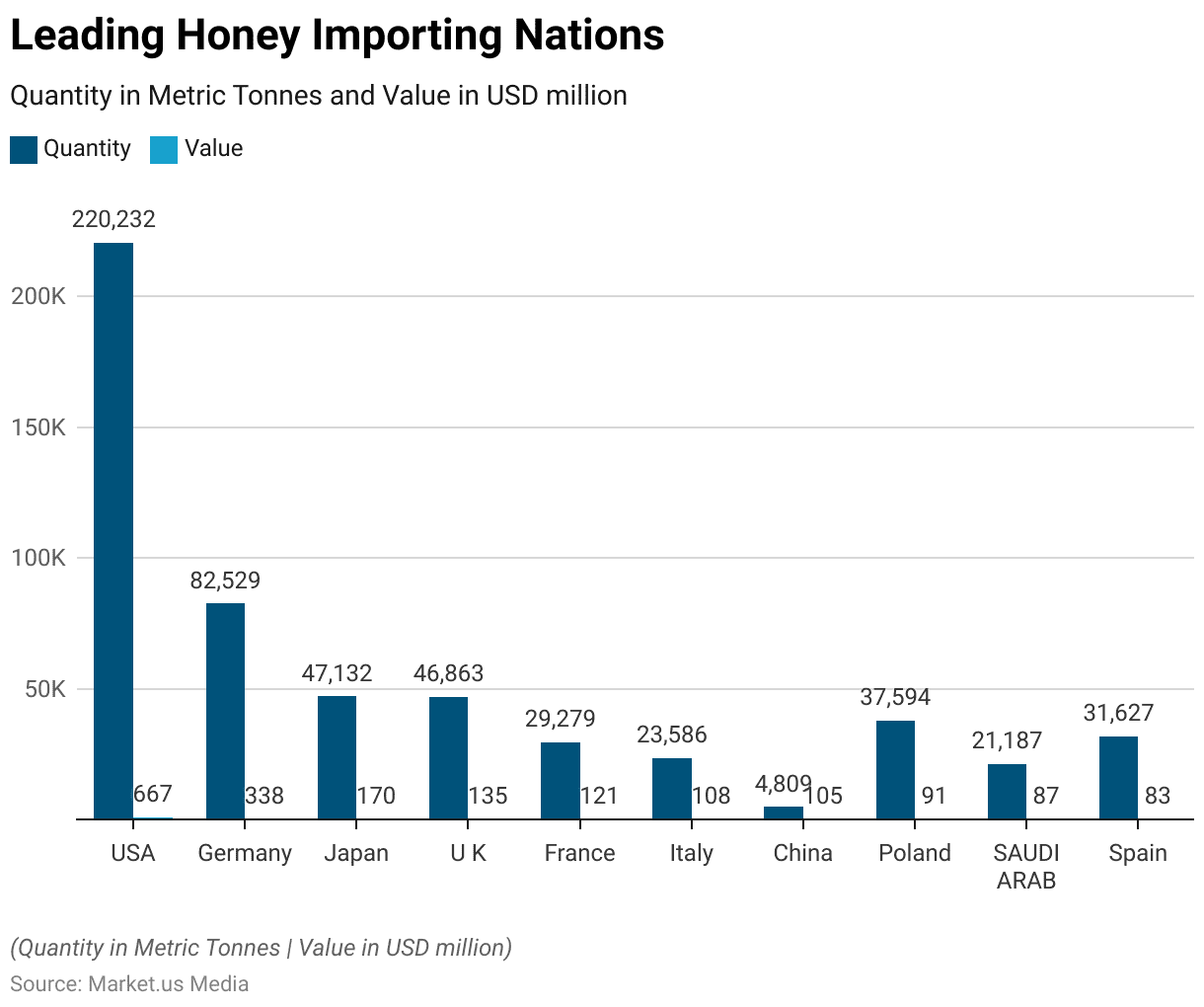
Regulatory Guidelines for Honey
- The Codex Alimentarius Commission has established 15 parameters concerning honey standards. For instance, the moisture content, except for heather honey, should not exceed 20%.
- Another important parameter is the sucrose content, which can indicate adulteration and should not exceed 5 grams per 100 grams, as outlined by the International Centre for Integrated Mountain Development (ICIMOD) in 2012.
- In more developed regions like the European Union (EU) and the United States (US), non-tariff measures (NTMs) tend to be stricter compared to the CODEX standards.
- This is also true for honey, where their NTMs appear to be more stringent than the CODEX safety guidelines. For example, the EU does not establish maximum residue levels (MRLs) for honey-based antibiotics, which means antibiotics cannot be used for treating bees.
Discuss your needs with our analyst
Please share your requirements with more details so our analyst can check if they can solve your problem(s)



